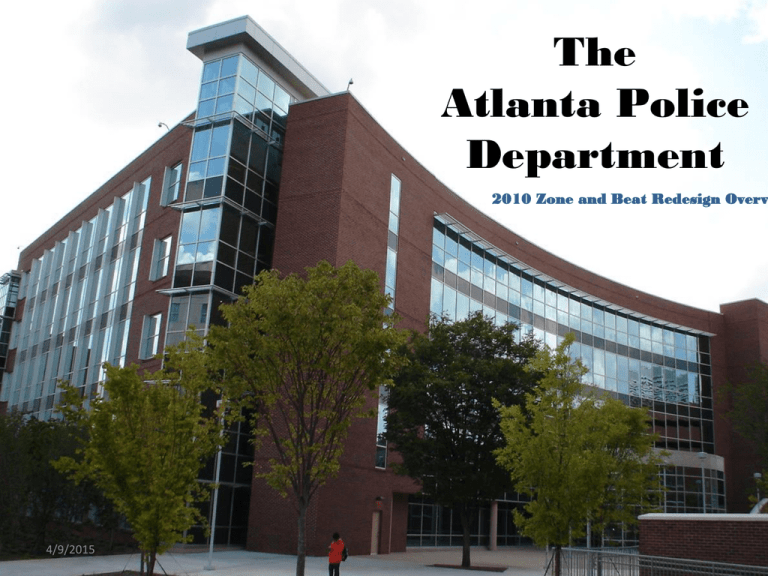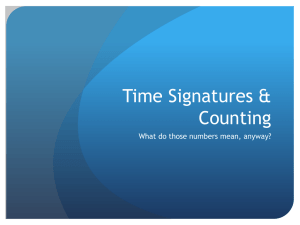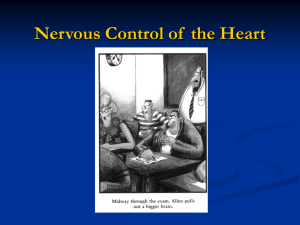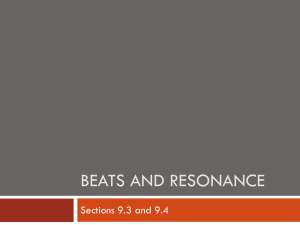Zone and Beat Redesign Overview Powerpoint Presentation
advertisement

The Atlanta Police Department 2010 Zone and Beat Redesign Overv 4/9/2015 The Objective: Chief Turner has charged The Field Operations Division and The Planning and Research/ Accreditation Unit to: • Analyze the Patrol Beats and Zones for the purpose of determining current workload distribution; and • Redesign the Beats and Zones where necessary to balance workload distribution and improves service delivery. 4/9/2015 The Objective: • The Atlanta Police Department formed a Zone and Beat Redesign Committee. • The Analytical and Management issues are: - Resource Allocation - Zone and Beat Redesign - Resource Determination 4/9/2015 Resource Allocation: The Department can and should: 1. Allocate its call-answering personnel to the Zones and to the watches : - the allocation should be in proportion to the patrol workload. 4/9/2015 Zone and Beat Redesign : Chief Turner has also charged the Zone and Beat Redesigning Committee with: • Analyzing the patterns of calls for service; and • Re-drawing Zone and Beat lines. 4/9/2015 Resource Determination: The Zone and Beat Redesign Committee has: • Analyzed its Calls-for-Service (CFS) workload; • Evaluated the response times to high priority calls; • Assessed the officers’ available time for community policing and other proactive work; and • Analyzed other factors, i.e. natural boundaries, interstates, railroad lines. 4/9/2015 The Introduction: “The Zones” The Zones are organized as follows: • Mobile Operations • Investigations • Field Investigation Team (FIT) and the Zone Discretionary Unit (ZDU) • Foot Patrol Units • Mini-Precincts 4/9/2015 The Introduction: “The Zones” Patrol Zones: • • • • • • Zone 1 (West Atlanta) Zone 2 (North Atlanta) Zone 3 (Southeast Atlanta) Zone 4 (Southwest Atlanta) Zone 5 (Downtown-Midtown) Zone 6 (East Atlanta) 4/9/2015 “The Beats” : • The Beat’s Defined Geographic Area. • The Beat Officer’s Expectations. • When the Beat is not busy, the Beat Officer may: – actively patrol the Beat; – look for problems to be addressed; and – talk with community members. • When the designated Beat is very busy, other officers may: – answer calls in the Beat, or – be assigned to the Beat. 4/9/2015 “The Beats” : • The Distribution of Beats. • The Beats Design. • The Connection of Beats to Neighborhoods. • Resolving Problems within the Beats. • Assignment of officers to Beats. 4/9/2015 The Redistricting Process: • The basic process of redesigning the Zones and Beats included: – The evaluation of the Calls-for-Service (CFS) workload data; and – The formation of appropriate geographic areas with roughly equal demand for police service. 4/9/2015 The Redesign Process (Considerations): • Basing the Beats on the Zone boundaries; • The Zone and Beat Redesign Financial Projections; • The Zone Precincts’ Transfers; • The Redesign of the Beats and the Cost of the Projected Project; and • Reallocating Infrastructure Expenses. 4/9/2015 Workload Measurements: The workload assessment for the Zone/Beat Redesign project was based on dispatched 911 calls for police service from July 2009 – June 2010. The following calls are excluded from the measure: • Calls of an administrative nature • Officer initiated incidents • Incidents serviced by the Georgia State Patrol and other agencies • Cancelled calls for service • Calls with invalid latitude/longitude fields • Calls serviced by Tele- Serve 4/9/2015 Workload Measurements: • The calls were categorized by their initial call type (signal) and their final disposition code. • Every call in the categories received the same Workload Scores. • The Workload Scores were calculated, as follows: Workload Calculation: 1. 2. 3. 4. The call length was calculated. The calls where more than one Officer was dispatched were multiplied. The average call length was calculated. Each call in a given category was assigned the average Workload Score. 4/9/2015 Workload Ratings: • The Workload Scores of all calls in the given Beat’s were summed, indicating that Beat’s total workload. • Each beat’s total Workload Score was then scaled into a standard Workload Rating . • The Workload Rating is a scale set such that a Beat with an average Workload Score would have a Rating of 100. • A Beat that has a Workload Rating of 120 has a workload 20% greater than average. 4/9/2015 Current Zones and Beats Zone Number of Beats Area (Mi2) Workload Rating Above/Below Average Zone 1 11 18.6 1023 -7.0% Zone 2 10 36.1 898 -18.3% Zone 3 12 21.0 1191 8.3% Zone 4 11 32.8 1274 15.9% Zone 5 11 8.2 1251 13.7% Zone 6 11 16.7 963 -12.5% The Targeted Workload Rating Per Zone is 1100 4/9/2015 Current Beat Workload Distribution (The City is currently divided into 66 beats of varying sizes.) The following is based on the calculation of the Workload Ratings for each beat: Above Average Beats Below Average Beats Beat Workload Rating 201 23 504 46 159 312 47 501 151 601 52 508 140 605 52 413 138 202 53 506 134 110 55 410 131 606 60 412 130 108 66 Beat Workload Rating 408 187 303 160 204 Beats with Workloads Outside of Acceptable Range: 4/9/2015 The Zone and Beat Redesign Plan 4/9/2015 The Zone and Beat Redesign Plan • The Plan is elucidated below: • “Zones and Beats Redesigned with Additional Beats Added”: • The Department can Redesign the Beats and Zone and add 12 more Beats . 4/9/2015 “Zones and Beats Redesigned with Additional Beats Added” (Adding Officers to the Zones) Number of Beats Square Miles Square Miles Per Patrol Officer Current Proposed Current Proposed Current Proposed Zone 1 11 14 18.6 20.0 1.7 1.4 Zone 2 10 13 36.1 39.5 3.6 3.0 Zone 3 12 13 21.0 20.9 1.8 1.6 Zone 4 11 14 32.8 31.3 3.0 2.2 Zone 5 11 12 8.3 6.8 0.8 0.6 Zone 6 11 12 16.7 15.0 1.5 1.3 Total Beats 66 78 4/9/2015 Balancing Zone Workload % Above/ Below Average Workload Workload Rating Current With Changes Current With Changes Zone 1 1031 1161 -6.3% 5.5% Zone 2 891 1051 -19.0% -4.5% Zone 3 1175 1158 6.8% 5.3% Zone 4 1267 1144 15.2% 4.0% Zone 5 1246 1030 13.3% -6.4% Zone6 990 1055 -10.0% -4.1% Target Workload 1100 “Zones and Beats Redesigned with Additional Beats Added” 4/9/2015 “Zones and Beats Redesigned with Additional Beats Added” Logistical Considerations: Zones: Vehicle Changes Personnel Changes Zone 1 +3 patrol cars +15 officers Zone 2 +3 patrol cars +15 officers Zone 3 +1 patrol car +5 officers Zone 4 +3 patrol cars +15 officers Zone 5 +1 patrol cars +5 officers Zone 6 +1 patrol cars +5 officers +12 patrol cars* + 60 officers* Total Implementation Costs: Redesigned Beat layout for CAD system: $57,000 Additional vehicles and officers are already included in current budget 4/9/2015 25 Implementation Timeline Six Weeks Contractor completes detailed Redesigning layout for CAD system. Implement Redesigned Beat plan into CAD system. Transfer officers and equipment to fill new Beat assignments. March 2011 4/9/2015 The Revised Beats 4/9/2015 Zone One 4/9/2015 Zone Two 4/9/2015 Zone Three 4/9/2015 Zone Four 4/9/2015 Zone Five 4/9/2015 Zone Six 4/9/2015 The End Questions and Answers: Chief George Turner Assistant Chief Peter Andresen 4/9/2015 Deputy Chief Ernest Finley Deputy Chief Shawn Jones Deputy Chief Calvin Moss








